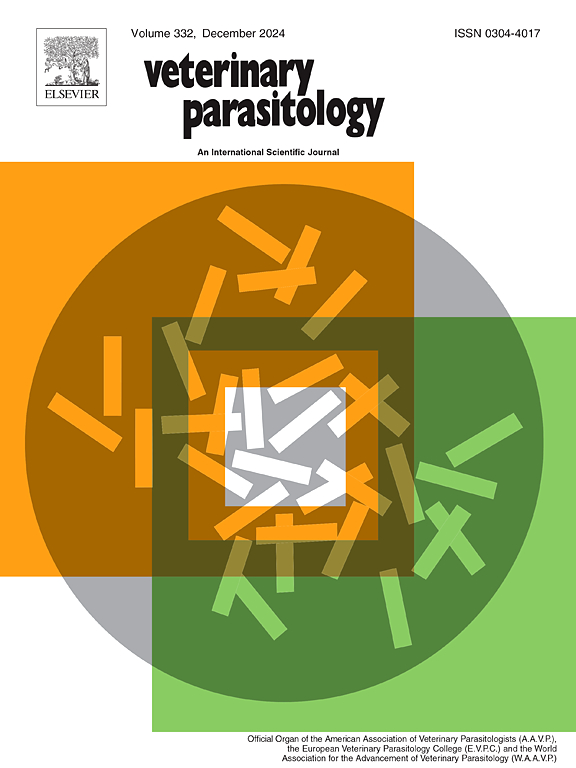衣原孢子虫的感染机制:肝片形吸虫虫卵控制的突破
IF 2
2区 农林科学
Q2 PARASITOLOGY
引用次数: 0
摘要
长期以来,传统的寄生虫管理一直受到耐药性和环境污染等问题的困扰。利用衣孢子虫进行生物防治已成为一种可持续的替代方法,但潜在的感染机制仍然难以捉摸。本研究旨在全面阐明这些机制,特别关注基因编辑的作用。利用光学、扫描电镜和透射电镜,我们观察到衣原体孢子虫感染肝片吸虫卵有三个不同的阶段。透射电镜分析首先显示了独特的感染钉,对初始蛋壳穿透至关重要。利用4D-DIA质谱技术,蛋白质组学鉴定了正常和线虫卵诱导菌丝体之间的208个差异表达蛋白,其中93个下调,115个上调。通过全面的蛋白质测序和随后的生物信息学分析,我们成功地鉴定了一个关键基因,命名为p1。为了了解p1的功能,我们使用了RNA干扰(RNAi)和过表达。我们构建了pSilent-1-p1 (RNAi载体)和pBARGPE1-p1(过表达载体)。过表达菌株pBARGPE-p1的丝氨酸蛋白酶活性显著增加(0.63 U/mL),表明其降解宿主组织的能力增强。相反,缺失菌株pSilent-1-p1的活性较低,表明p1基因在蛋白酶产生中起着至关重要的作用。在对三种线虫卵的感染效率进行评估时,过表达株和沉默株均呈下降趋势。沉默菌株的感染率显著降低,平均为45.22 %,突出了p1基因在真菌寄生能力中的重要性。值得注意的是,菌株之间在孢子浓度、菌丝生物量和生长速率方面没有显著差异。这些以p1基因为中心的研究结果为衣原体的生物防治机制提供了全面的见解,为制定更高效、更环保的寄生虫管理策略奠定了坚实的理论基础。本文章由计算机程序翻译,如有差异,请以英文原文为准。
Infection mechanisms of Pochonia chlamydosporia: A breakthrough in Fasciola hepatica egg control
Traditional parasite management has long been plagued by issues such as drug resistance and environmental pollution. Biological control using Pochonia chlamydosporia has emerged as a sustainable alternative, yet the underlying infection mechanisms remain elusive. This study aimed to comprehensively elucidate these mechanisms, with a particular focus on the role of gene editing. Employing optical, SEM, and TEM microscopy, we observed that P. chlamydosporia infects Fasciola hepatica eggs in three distinct stages. TEM analysis first visualized unique infection pegs crucial for initial eggshell penetration. Using 4D-DIA mass spectrometry, proteomics identified 208 differentially expressed proteins between normal and nematode - egg - induced mycelium, of which 93 were downregulated and 115 were upregulated. Through comprehensive protein sequencing and subsequent bioinformatics analyses, we successfully identified a key gene, designated p1. To understand p1's function, we used RNA interference (RNAi) and overexpression. We constructed pSilent-1-p1 (RNAi vector) and pBARGPE1-p1 (overexpression vector). The overexpression strain pBARGPE-p1 demonstrated a remarkable increase in serine protease activity (0.63 U/mL), indicating an enhanced ability to degrade host tissues. Conversely, the deletion strain pSilent-1-p1 had lower activity, indicating the crucial role of the p1 gene in protease production. When assessing the infection efficiency against three types of nematode eggs, both the overexpressed and silenced strains exhibited a downward trend. The silenced strain had a significantly reduced infection rate, with an average of 45.22 %, highlighting the importance of the p1 gene in the fungus's parasitic ability. Notably, no significant differences were observed among strains with respect to spore concentration, mycelial biomass, and growth rate. These findings, centered on the p1 gene provide comprehensive insights into the biological control mechanisms of P. chlamydosporia, establishing a solid theoretical foundation for the development of more efficient and environmentally friendly parasite management strategies.
求助全文
通过发布文献求助,成功后即可免费获取论文全文。
去求助
来源期刊

Veterinary parasitology
农林科学-寄生虫学
CiteScore
5.30
自引率
7.70%
发文量
126
审稿时长
36 days
期刊介绍:
The journal Veterinary Parasitology has an open access mirror journal,Veterinary Parasitology: X, sharing the same aims and scope, editorial team, submission system and rigorous peer review.
This journal is concerned with those aspects of helminthology, protozoology and entomology which are of interest to animal health investigators, veterinary practitioners and others with a special interest in parasitology. Papers of the highest quality dealing with all aspects of disease prevention, pathology, treatment, epidemiology, and control of parasites in all domesticated animals, fall within the scope of the journal. Papers of geographically limited (local) interest which are not of interest to an international audience will not be accepted. Authors who submit papers based on local data will need to indicate why their paper is relevant to a broader readership.
Parasitological studies on laboratory animals fall within the scope of the journal only if they provide a reasonably close model of a disease of domestic animals. Additionally the journal will consider papers relating to wildlife species where they may act as disease reservoirs to domestic animals, or as a zoonotic reservoir. Case studies considered to be unique or of specific interest to the journal, will also be considered on occasions at the Editors'' discretion. Papers dealing exclusively with the taxonomy of parasites do not fall within the scope of the journal.
 求助内容:
求助内容: 应助结果提醒方式:
应助结果提醒方式:


